Battle of Belmont
| Battle of Belmont | |||||||
|---|---|---|---|---|---|---|---|
| Part of the American Civil War | |||||||
|
Charleston defenses, Belmont battlefield by Julius Bien & Co., Lith., N.Y. |
|||||||
|
|||||||
| Belligerents | |||||||
|
|
|
||||||
| Commanders and leaders | |||||||
| Ulysses S. Grant | Gideon J. Pillow | ||||||
| Strength | |||||||
| 3,114 | ∼ 5,000 | ||||||
| Casualties and losses | |||||||
|
607
(120 killed;
383 wounded; 104 captured/missing) |
641
(105 killed;
419 wounded; 117 captured/missing) |
||||||
The Battle of Belmont was fought on November 7, 1861 in Mississippi County, Missouri. It was the first combat test in the American Civil War for Brig. Gen. Ulysses S. Grant, the future Union Army general in chief and eventual U.S. president; Grant's troops in this battle were the "nucleus" of the Union Army of the Tennessee.
On November 6, Grant moved by riverboat from Cairo, Illinois, to attack the Confederate's small outpost near Belmont, Missouri across the Mississippi River from the Confederate stronghold at Columbus, Kentucky. He landed his men on the Missouri side and marched to Belmont. Grant's troops overran the surprised Confederate camp and destroyed it. However, the scattered Confederate forces quickly reorganized and were reinforced from Columbus. They then counterattacked, supported by heavy artillery fire from across the river. Grant retreated to his riverboats and took his men to Paducah, Kentucky. The battle was relatively unimportant, but with little happening elsewhere at the time, it received considerable attention in the press.
At the beginning of the war, the critical border state of Kentucky, with a pro-Confederate governor but a largely pro-Union legislature, declared neutrality between the opposing sides. Pro-Confederates Kentuckians crossed into Tennessee to enlist, but the Union men openly formed a recruiting camp inside Kentucky violating the state's neutrality. In response, Confederate Maj. Gen. Leonidas Polk moved Confederate forces into Kentucky on September 3, 1861 and occupied Columbus, a key position on the bluffs overlooking the Mississippi River. Three days later Union Brig. Gen. Ulysses S. Grant seized Paducah. Grant, commanding the District of Southeast Missouri, requested permission from theater commander Maj. Gen. John C. Frémont to attack Columbus, but no orders came. For the next two months only limited demonstrations were conducted against the Confederates.
...
Wikipedia

